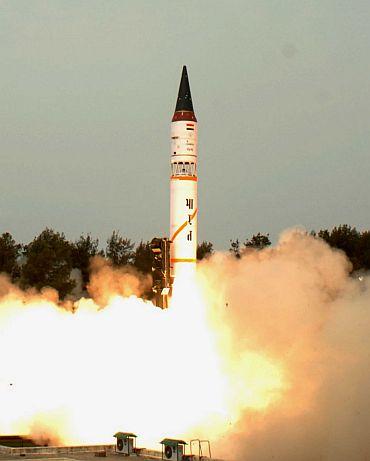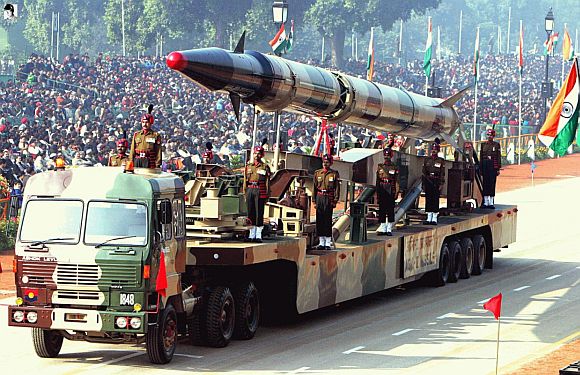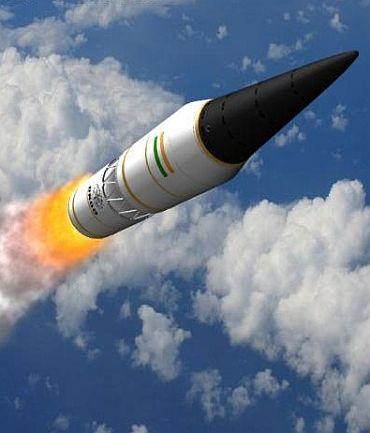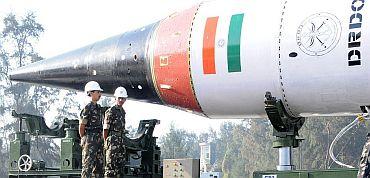 | « Back to article | Print this article |
On TEST in December: 5000 km-range Agni-5
After three successful ballistic missile tests during the last fortnight, the Defence Research and Development Organisation is finalising preparations for the big one.
In December, the giant Agni-5 missile will undergo its first-ever test, blasting off from Wheeler Island, on the Odisha coast, and travelling its full range of over 5,000 kilometres to a target in the southern Indian Ocean.
The Agni-5 is debuting with a full-range test for two reasons.
Firstly, so that there is no question about how far the missile can strike. Secondly, to test not just the missile, but also whether the DRDO's monitoring networks can cope with such enormous ranges, tracking the Agni-5 every moment en route to a target 5000 kilometres away.
This will involve transporting a DRDO team and its tracking equipment on Indian Navy warships deep into the southern reaches of the Indian Ocean.
Click on NEXT to read further...
On TEST in December: 5000 km-range Agni-5
"The Agni-5 missile will travel halfway to Antarctica. The missile's designers are certain [about the missile's range] but we will demonstrate it for the users," says Dr Avinash Chander, Chief Controller for Missiles and Strategic Systems in the DRDO.
As director of the Hyderabad-based Advanced Systems Laboratory (ASL), Chander oversaw much of the development of the Agni-5.
Talking exclusively to Business Standard, he describes how the three-stage, 50-ton, 17.5-metre high missile will be powered off the Wheeler Island launch pad by its giant first sta#8805 within minutes it will be in space, powered by a brand new, all-composite second stage.
After heading southwards for 2,000 kilometres it will cross the equator. Then it will hurtle through space for another 3000-kilometers or so, re-entering the atmosphere over the Tropic of Capricorn and splashing down at the target somewhere between the southern tip of Africa and Australia.
Click on NEXT to read further...
On TEST in December: 5000 km-range Agni-5
Following international practice, the DRDO will issue advisories before the test, giving out the launch window and warning shipping and air traffic to stay clear of the target area.
Explains Chander: "No Indian missile has ever travelled so far except for ISRO rockets. But those remain in space and there is no requirement to monitor their re-entry. Besides, space is a collaborative environment, with establishments worldwide cooperating in tracking a rocket. For the Agni-5 we have to develop a network of tracking systems, which will do the job out to 5000 km and beyond. And our ships will have to be at the target area to collect the data."
While the Indian Navy had declined to officially comment, senior sources confirm that one of the navy's Offshore Patrol Vessels (OPVs) will position itself at the target end, with a DRDO team on board, equipped with tracking and communications equipment.
The DRDO predicts a highly accurate missile, which will strike within a few hundred metres of the designated target even after travelling 5000 kilometres. This would allow the operational version of the Agni-5 to carry a smaller nuclear warhead.
Click on NEXT to read further...
On TEST in December: 5000 km-range Agni-5
"Megaton warheads were used when accuracies were low. Now we talk of [accuracy of] a few hundred metres. That allows a smaller warhead, perhaps 150-250 kilotons, to cause substantial damage. We don't want to cause wanton damage [with megaton warheads]", says Chander.
The Agni-5's 5,000-kilometre range, say nuclear strategists, is carefully calibrated. It can reach targets across the globe, except for America and Australia. This prevents alarm bells from going off in friendly capitals, while establishing and strengthening nuclear deterrence against all possible enemies.
"Agni-5 will take us to a level of 5,000-km plus class of missile systems which meets all our threat requirements," said VK Saraswat, the DRDO chief at a public function recently.
Click on NEXT to read further...
On TEST in December: 5000 km-range Agni-5
The Agni-5's range just keeps it in the class of intermediate range ballistic missiles (IRBMs), which are missiles with ranges of 3,000-5,500 kilometres. DRDO sources indicate, however, that the Agni-5 could easily be ramped up into an intercontinental ballistic missile (ICBM), having a range greater than 5500 kilometres.
The Agni-5 is similar in size and weight to its predecessor, the Agni-3, with a range of 3,500 kilometers. But the extensive use of composite materials allows the Agni-5 to propel a warhead 1500 kilometers further. While the first stage remains unchanged from the Agni-3, the second stage is significantly lighter, being made of composites. This has allowed a third stage, also composite, to be fitted, extending the range of the missile.
Engineering the third stage was a major technology challenge. "The third stage, which slopes into the warhead stage, has a conical motor. So far, we have only been doing cylindrical motors; never a shaped motor," explains Chander.
Another distinctive feature of the Agni-5 is its "canisterisation". Hermetically sealed into an airtight canister that is mounted on a flatbed truck, the missile can be easily transported and fired quickly by hydraulically raising the canister into the vertical firing position. Made from high-strength maraging steel, the canister must absorb enormous stresses during firing, when a thrust of 300-400 tons is generated to eject the 50-ton missile. The canister also provides a hermitically sealed atmosphere in which the missile is stored safely for years.
Click on MORE to read another PHOTO FEATURE...





